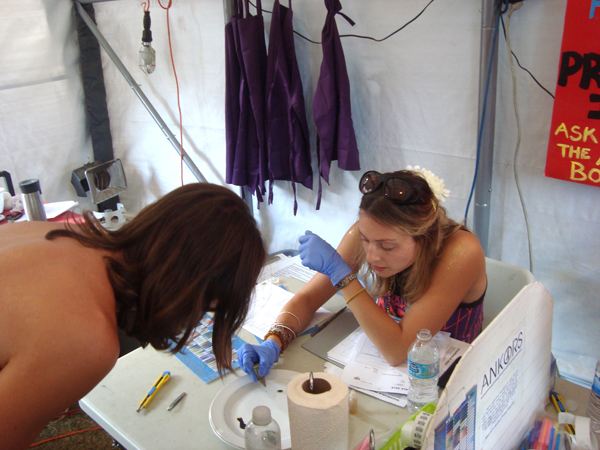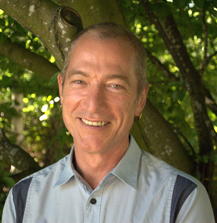Drug checking at music festivals
by Warren Michelow
The summer music festival season is full of fun and excitement, but there can be a dark side to the exuberance—people overdosing or suffering negative effects from drugs. Too often, what someone buys as ecstasy turns out to be something else, including chemicals with a history of causing injury or death. Enter drug checking, a quick and simple method for screening drug samples. The technique uses reagents to indicate the presence of target chemicals through changes in colour. While most of these tests don’t determine dose or purity, they do help people know if they are getting what they paid for and can identify contaminants or unwanted substances.
Drug checking using both reagent-based screening and mobile laboratories has been available at European venues since the 1990s. To date, tougher drug control in North America has made it harder to provide drug checking here; nevertheless, several community groups in Canada and USA have offered drug checking at events over the years. For example, ANKORS (AIDS Network Kootenay Outreach and Support Society) in Nelson, BC has provided drug checking at the Shambhala Music Festival for over a decade1.

Chloe Sage from ANKORS and Warren Michelow, a graduate student associated with CARBC, have just released “Drug checking at music festivals: A how-to guide”, funded by the BC Ministry of Health, that distills knowledge and practices learned from providing drug checking and other harm reduction services at music festivals and events since the early 2000s. The guide is intended to help people in the community and public health groups interested in providing services at events or in other community settings. It describes in practical detail how to set up and run a drug checking service, how it can fit with other health-related services at a festival, and how to do the testing in a legal way.
Drug checking services are accessed by people interested enough in using drugs to already be in possession of a substance they intend to use. Seeking out drug checking demonstrates an interest in health-oriented information about substance use and potential hazards associated with the substance they think they have. Describing the strengths and limitations of results from reagent-based screening and getting confirmation of understanding is a key part of a drug checking encounter (see “Testing Disclaimer” in the Guide for an example). The natural flow of a testing encounter offers a scaffold to engage in conversation about drug-related knowledge and strategies for responsible use and managing risk. Field experience shows that after receiving an unexpected result—especially one that suggested the presence of something known to be harmful, e.g., suspected PMMA—people choose to dispose of that substance rather than take it2.
Between 2008 and 2015, the United Nations early warning system received reports of 644 new psychoactive substances with 75 being reported in the first part of 2015 alone3. Sometimes these are sold as exotic new “legal highs”, but often they are misrepresented as more popular and better known drugs such as ecstasy or LSD. Being so new, we know little about the potential for adverse health effects from consuming these substances.
Having capacity to screen for misrepresented substances and known hazardous substances is an essential tool for preventing avoidable harm at festivals and other entertainment venues where substance use takes place. In the absence of any better alternative, rapid presence/absence screening serves a vital public health function.
Download the guide and find related resources at http://michelow.ca/drug-checking-guide/ and http://www.ankorsvolunteer.com/.
1 Warren Michelow, Cheryl Dowden. “Start Small, Take it Easy” Results from the ANKORS Harm Reduction Survey at the 2013 Shambhala Music Festival. Available at http://michelow.ca/r/smf2013rep.
2 Chloe Sage. Harm Reduction and Drug Checking: A wrap-around service for festivals. Case Study: Shambhala Music Festival /ANKORS Drug Checking Harm Reduction Service data 2015. Available at http://michelow.ca/r/smf2015dcsum.
3 United Nations Office On Drugs and Crime. World Drug Report 2016. (United Nations publication, Sales No. E.16.XI.7). Available at http://www.unodc.org/wdr2016/.
 Warren Michelow is a graduate student affiliated with the Centre for Addictions Research of BC. He is currently a Ph.D. candidate in the School of Population and Public Health at UBC and his doctoral research is on simultaneous polysubstance among mainstream substance users. He has received the Frederick Banting and Charles Best Canada Graduate Scholarships Doctoral Award, the Integrated Mentor Program in Addictions Research Training Fellowship and a MITACS ACCELERATE Internship.
Warren Michelow is a graduate student affiliated with the Centre for Addictions Research of BC. He is currently a Ph.D. candidate in the School of Population and Public Health at UBC and his doctoral research is on simultaneous polysubstance among mainstream substance users. He has received the Frederick Banting and Charles Best Canada Graduate Scholarships Doctoral Award, the Integrated Mentor Program in Addictions Research Training Fellowship and a MITACS ACCELERATE Internship.

Warren, the author, again. A follow up thought regarding the motivation for development of new psychoactive substances (NSPs).
TL;DR – NSPs are developed specifically to be different enough from illegal chemicals to be “legal highs”.
We suspect that one of the main drivers of the development of NSPs is to get around legal issues associated with prohibition of many psychoactive substances. It varies by country but the typical method for making a substance illegal is for a government to add it to a “schedule” of “controlled substances”. Typically each schedule is associated with specific conditions of use and varying levels of restrictions on use, manufacture, supply, etc.
A number of the schedules are for substances that are highly controlled because of high potential for abuse, high likelihood of harm if misused, or very limited potential for medical usage. Usually at least one schedule will be for substances that are flat out illegal to posses, manufacture or distribute – this is where many of the popular recreational drugs are listed and is how they are made illegal.
To add a drug to a schedule requires describing the chemical in some fairly precise way – usually in terms of its precise chemical structure or the signature characteristic structure of the family of related chemicals it belongs to. Thus, if one could make a variation of an illegal substance that still has psychoactive properties but which is sufficiently different in chemical structure to no longer fit the description on the schedule, then one has made a new “legal high”. E.g., for many years in Canada, 2C-B was scheduled and illegal, but 2C-I was sufficiently different (I=iodine vs B=bromine) that 2C-I was essentially legal.
There is thus an ongoing “battle” between government adding chemicals to its schedules to regulate and control them, and chemists who wish to make psychoactive substances that are not currently illegal. The more chemists learn about how the structure of a molecule makes it psychoactive the better they get at inventing new psychoactive substances. For an example of a reputable researcher who very methodically and systematically researched whole families of psychoactive chemicals, check out Dr Alexander Shulgin’s two massive works: PHIKAL (Phenylethylamines I’ve Known and Loved) and TIKAL (Tryptamines IKAL).
The takeaway though, is that prohibition will never work in the long run – it will always be trying to catch up with ever-more innovative and creative chemists and ever-increasing knowledge about what makes a molecule psychoactive. There will always be a need for other ways to try to catch substances that may be misrepresented or that are known to have potential for harm, and drug checking is one of the currently available and practicable ways this can be done.
Hi this is the author of the post – thanks for the comment! I’m not sure how practical or effective your suggestion would be, but it does touch on some relevant points that I can respond to.
It is an open question how much sellers of psychoactive substances – illegal or not – might be interested in the quality or provenance of their wares. There are indeed some responsible ‘dealers’ who would care about quality and care about not inadvertently supplying misrepresented product. If they had access to community-based drug checking at a health facility or community organisation then it might help these folks check what they have is what they think it is – that way at least some misrepresented substances could be kept out of the supply.
The bigger issue with novel psychoactive substances is that they are usually (not always) new, thus there is typically little information about how safe they are to use – both one-time and repeatedly over time – and how to use them in a beneficial way (e.g., appropriate dosing, most conducive setting, risk factors for adverse effects, etc.).
On top of that, much of the drug checking technology is based on how known chemicals react with screening reagents, or some knowledge of chemical properties such as molecular weight range, ability to be ionized, etc. When one starts with an essentially unknown (novel) substance then the testing process is a lot more complex and time consuming and is complicated even more by the almost certainty that the novel substance is mixed in with a bunch of other stuff in the pill or powder.
In terms of protecting the health of people who do use substances, it is probably more useful for dealers or potential users to be able to check that they are getting something reliable and well known. In these cases, having access to reliable and confidential/anonymous drug checking in the community before an event could be very useful from a health and safety perspective indeed.
“Between 2008 and 2015, the United Nations early warning system received reports of 644 new psychoactive substances with 75 being reported in the first part of 2015 alone3. Sometimes these are sold as exotic new “legal highs”, but often they are misrepresented as more popular and better known drugs such as ecstasy or LSD. Being so new, we know little about the potential for adverse health effects from consuming these substances.”
-Wouldn’t it be easier to get the non-descript ‘manufacturers’ to submit product -prior to the event- via a unidentified person and then reduce the possibility of promoting copious quantities of pre-set ‘cooked’ product from entering into the stream of the localized event?